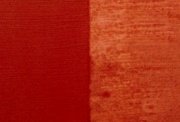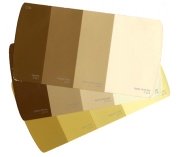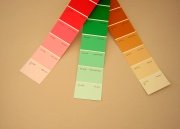House Paint Color
Undertones - Part 2
House paint color undertones have the power to make or break your home color scheme. Let's learn how to see these subtle nuances in color...
NOTE: if you don't know what an undertone is, see "Interior Paint Color Undertones - Part 1".
Why House Paint Colors
Have Undertones
Before I show you how to see color undertones, you have to understand how different colors are created. For that, you'll want to briefly review the paint color mixing chart. And please don't skip this step - you will need these principles later in this tutorial!

The chart will show you that, with the exception of 3 primary colors (red, yellow and blue), all other hues are created by mixing 2 or more colors together. So the undertone of any given color will depend on which colors were combined and what proportions were used in the formula.
For example, when you mix equal amounts of yellow and blue, you get "pure" green. But if you use just a tad more blue than yellow in the mix, you will still get green - but it will have a bluish undertone.
That's one of the ways paint manufacturers are able to create hundreds of shades of any single color (this is called extending a color).
Because of the way house paint colors are mixed, any color you see on the paint color wheel can only have an undertone from one of its two closest neighbors. For instance, greens only come in yellow and blue undertones (moss green vs sea green), reds can be yellowish or bluish (carrot red vs berry red), and so on.
There is no need to memorize all this - just look at the color wheel, locate your color, and then see what colors lie on its left and right.
Now with the colors you don't see on the color wheel - neutrals like gray or beige - it's a little different. To keep it simple, I won't go into how neutrals are mixed (they can be pretty complex). So just remember that beige can have a red/pink, yellow/orange or green tint to it. Grays will usually be on the bluish, violet or greenish side.
How to See Undertones
in House Paint Colors
Spread the Paint

Drop some paint on a white sheet of paper. Then use a painting knife to spread the paint very thinly until you can see through it. Alternatively, you can use a brush to feather out the paint.
Do you notice the yellow undertone in this red now?
When a paint color is sheer, you can more easily detect its undertone. This exercise is a great way to practice recognizing nuances in colors.
Compare the Color to Other Shades

Another exercise is to see different shades of the same color next to each other. You will notice that even though they all belong to the same color family, their undertones will be different.
Likewise, you can compare every shade to the "true" color - the one that has no undertones. For example, see different shades of blue alongside with the "real" blue.
Whites (yes, they have undertones, too!) should always be compared to the whitest white in your paint deck - otherwise it's almost impossible to distinguish their undertones.
Compare the Color to Other Hues

This final exercise will help you figure out the undertone in neutral house paint colors.
To find out whether your beige has any red, yellow or green to it, compare it to the complementary hues (green, violet and red, respectively) - but one at a time!
Complementary colors intensify each other, so for example, if your beige has red added to it, the undertone will reveal itself when you view this beige next to green.
The undertones in gray will become more obvious when you compare the color to red, orange and yellow.
It will seem challenging at first, but remember - practice makes perfect!
To learn how to coordinate colors based on their undertones, value and intensity, go to: "Tweaking and Matching Paint Colors".









Leave a Comment: